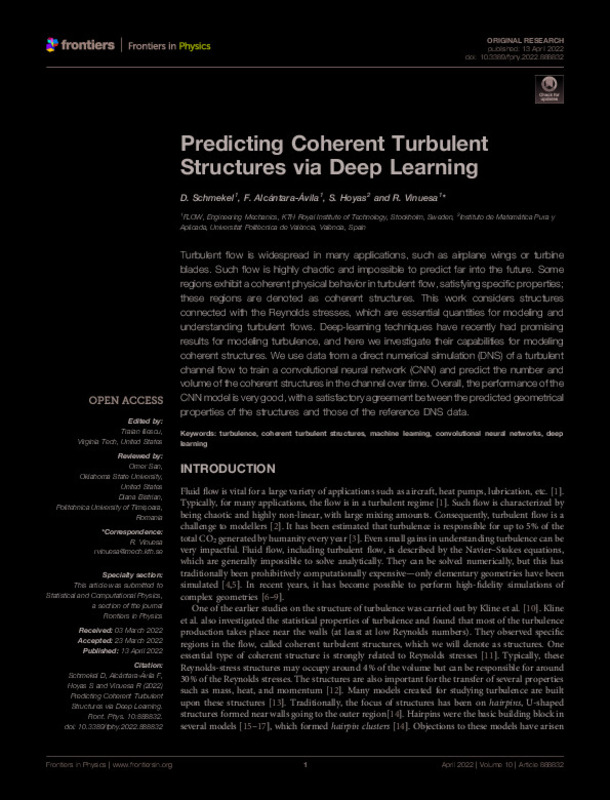JavaScript is disabled for your browser. Some features of this site may not work without it.
Buscar en RiuNet
Listar
Mi cuenta
Estadísticas
Ayuda RiuNet
Admin. UPV
Predicting Coherent Turbulent Structures via Deep Learning
Mostrar el registro sencillo del ítem
Ficheros en el ítem
| dc.contributor.author | Schmekel, D.
|
es_ES |
| dc.contributor.author | Alcántara-Ávila, Francisco
|
es_ES |
| dc.contributor.author | Hoyas, S.
|
es_ES |
| dc.contributor.author | Vinuesa, R.
|
es_ES |
| dc.date.accessioned | 2023-07-04T18:01:37Z | |
| dc.date.available | 2023-07-04T18:01:37Z | |
| dc.date.issued | 2022-04-13 | es_ES |
| dc.identifier.uri | http://hdl.handle.net/10251/194672 | |
| dc.description.abstract | [EN] Turbulent flow is widespread in many applications, such as airplane wings or turbine blades. Such flow is highly chaotic and impossible to predict far into the future. Some regions exhibit a coherent physical behavior in turbulent flow, satisfying specific properties; these regions are denoted as coherent structures. This work considers structures connected with the Reynolds stresses, which are essential quantities for modeling and understanding turbulent flows. Deep-learning techniques have recently had promising results for modeling turbulence, and here we investigate their capabilities for modeling coherent structures. We use data from a direct numerical simulation (DNS) of a turbulent channel flow to train a convolutional neural network (CNN) and predict the number and volume of the coherent structures in the channel over time. Overall, the performance of the CNN model is very good, with a satisfactory agreement between the predicted geometrical properties of the structures and those of the reference DNS data. | es_ES |
| dc.description.sponsorship | RV acknowledges the financial support by the Göran Gustafsson foundation. SH was funded by Contract Nos. RTI2018-102256- B-I00 of Ministerio de Ciencia, innovación y Universidades/ FEDER. Part of the analysis was carried out using computational resources provided by the Swedish National Infrastructure for Computing (SNIC). | es_ES |
| dc.language | Inglés | es_ES |
| dc.publisher | Frontiers Media | es_ES |
| dc.relation.ispartof | Frontiers in Physics | es_ES |
| dc.rights | Reconocimiento (by) | es_ES |
| dc.subject | Turbulence | es_ES |
| dc.subject | Coherent turbulent structures | es_ES |
| dc.subject | Machine learning | es_ES |
| dc.subject | Convolutional neural networks | es_ES |
| dc.subject | Deep learning | es_ES |
| dc.subject.classification | INGENIERIA AEROESPACIAL | es_ES |
| dc.title | Predicting Coherent Turbulent Structures via Deep Learning | es_ES |
| dc.type | Artículo | es_ES |
| dc.identifier.doi | 10.3389/fphy.2022.888832 | es_ES |
| dc.relation.projectID | info:eu-repo/grantAgreement/AEI/Plan Estatal de Investigación Científica y Técnica y de Innovación 2017-2020/RTI2018-102256-B-I00/ES/TRANSFERENCIA DE CALOR EN FLUJOS DE PARED: CANALES Y CAPAS LIMITES/ | es_ES |
| dc.rights.accessRights | Abierto | es_ES |
| dc.contributor.affiliation | Universitat Politècnica de València. Escuela Técnica Superior de Ingeniería del Diseño - Escola Tècnica Superior d'Enginyeria del Disseny | es_ES |
| dc.description.bibliographicCitation | Schmekel, D.; Alcántara-Ávila, F.; Hoyas, S.; Vinuesa, R. (2022). Predicting Coherent Turbulent Structures via Deep Learning. Frontiers in Physics. 10:1-9. https://doi.org/10.3389/fphy.2022.888832 | es_ES |
| dc.description.accrualMethod | S | es_ES |
| dc.relation.publisherversion | https://doi.org/10.3389/fphy.2022.888832 | es_ES |
| dc.description.upvformatpinicio | 1 | es_ES |
| dc.description.upvformatpfin | 9 | es_ES |
| dc.type.version | info:eu-repo/semantics/publishedVersion | es_ES |
| dc.description.volume | 10 | es_ES |
| dc.identifier.eissn | 2296-424X | es_ES |
| dc.relation.pasarela | S\481312 | es_ES |
| dc.contributor.funder | AGENCIA ESTATAL DE INVESTIGACION | es_ES |
| dc.contributor.funder | European Regional Development Fund | es_ES |








